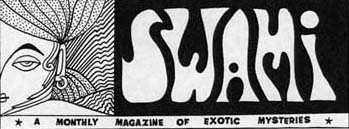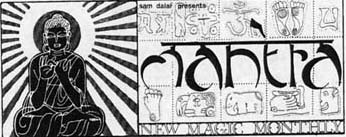


|
Swami and Mantra were two magazines published in the seventies by Sam Dalal, distributed from Calcutta, India. Swami ran for 36 issues, from January 1972-December 1974, and Mantra ran for 28 issues, from April 1975-July 1977. Each issue was a four-page sheet of tricks, of the class and character of Jinx, The New Phoenix, and Swami/Mantra's contemporary, The Pallbearers Review. Swami/Mantra's traditional card and coin and mental material matched that of those magazines, with contributions by some of the best of Western magicians coupled with excellent offerings by unknown (to us in remote places like Indiana) Eastern magicians. But, in addition to presenting new material and new faces, Swami and Mantra also exposed the world to an entirely new kind of magic to Western eyes, under the classifications of Yoga Maya and Jadoo. These demonstrations, some terrifying, have crept into "geek magic" performances in recent years, in the acts of such luminaries as Harry Anderson and Rudy Coby. There are secrets in this book that you will find nowhere else. Why two titles? Sam Dalal, in his introduction to the collected volume, explains that Swami ran, in part, under the patronage of the late Mr. K.C. Batra. When Mr. Batra became disassociated with the magazine, Dalal began a new journal of the same nature under its new title, Mantra. Both magazines were more a labor of love than a labor of profit (a situation with which I am intimately familiar). There are a couple of minor differences in the magazines. The exotic Eastern magic or stunts ran in Swami under a column titled "Yoga Maya" and in Mantra under the title "Jadoo." Swami intentionally carried no editorials (other than the first one stating that there would be no editorials). Mantra added a section of commentary called "The Backyard" that ran in many of the issues. I have always enjoyed such personal columns, in such instances as Bruce Elliott's (and Jay Marshall's) "The Back Room," Karl Fulves's "Babel," Charlie Miller's "Intermission," Harry Lorayne's "Out to Lunch," and so on. They personalize the magazines and form little monthly time capsules of the magic of the day. One such case in Mantra is from the February 1977 issue, in which Dalal notes the publication of The Magic of Tan Hock Chuan by Magic Limited for only $7.50. (Tan Hock Chuan was a frequent contributor to Swami and Mantra and is featured elsewhere in this issue of the Gazette.) Also in that column are hypes for Phil Goldstein's Red Book of Mentalism ($3.00) and that terrific hardcover coffee table book, The World's Greatest Magic. Simpler times, wonderful prices. Before mentioning a few favorite effects from this collection, allow me to drop a few names: Peter Warlock, Sam Dalal, Micky Hades, Milt Kort, Ken De Courcy, Martin Gardner, Paul Marcus, Tony Shiels, Sam Schwarz, Alan Shaxon, Sid Lorraine, Al Mann, Art Emerson, Eddie Joseph, Pavel, Charles Cameron, Kirk Stiles, Ed Marlo, Horace Bennett, Tenkai, Will Dexter, Mike Rogers, Terry Seabrooke, Phil Goldstein, J.K. Hartman, and Tom Fitzgerald. Strong contributions from these magicians and equally strong items from names you might not be as familiar with make this a book full of practical, commercial magic (not to mention some powerful if impractical material I'll cite below). |

 Following are a few "normal" magic tricks that stood out for me: "Poor Man's Card Castle" is Mike Roger's impromptu card castle which earned him a certain notoriety in the seventies. "Pharaoh's Palm" by Al Mann is a biological method for doing a billet switch. "Hallucination" is a spooky switch of a selected card from one envelope held by a spectator to a sealed envelope in the performer's pocket. This was submitted by a sixteen-year-old girl (in 1972) named Shanta Batra. Miss Batra was quite a prodigy. "Pegasus Page" by Art Emerson is in the "Trick Without A Name" category in which a page leaves a book to be found elsewhere. "Brainwave Bandwagon" by Sam Dalal is an amazing new version of the classic "Brainwave" deck. Consider these conditions: (1) Any card can be named. (2) Deck can be show front and back (faces and backs). (3) Named, reversed card is shown to have a different color back. (4) Only one deck is used, and it contains only 52 cards. In "Psychic Identification," a genuinely blindfolded mystic has several mixed up finger rings, including one of his own, placed into a spectator's pockets. He then identifies which pockets hold which rings. "Who's Who" is another by Shanta Batra, involving a miniature card and a normal sized card. Can't tip the effect without sort of tipping the method, but this is neat. "Oil and Water" by Ed Marlo. If I am reading this correctly, including a 1951 letter from Marlo, this is the original version of "Oil and Water," the one that started it all, which specifically departed from the "Follow the Leader" effect and with which Marlo fooled Vernon. It's a 10 black card/10 red card version. "The Twist" by George Blake and "Twisting the Aces Again" by Sam Dalal are, respectively, interesting gaffed and non-gaffed versions of "Twisting the Aces." "Suit Yourself" is a Horace Bennett version of the cards through the newspaper, popularized in the seventies by Albert Goshman. "13!" is a fine clock effect by Subir Kr. Dhar. "Houdini's Shoe" is a great comedy-mystery for table hoppers. You first produce a tennis shoe from under a napkin. Spectators then hold the ends of the laces, and under cover of the napkin the shoe escapes from its lace. "Product-ion" is a method of gimmicking a box, such as a cereal box, so that you can make a large production from it. The gimmick is self-contained. "Down the Tubes" by Phil Goldstein is, in its simplest form, a prediction effect using a bill tube. The method however is of extraordinary utility to any of you who have had trouble loading a device (such as a bill tube) in your pocket. This solved a problem that has been bugging me for a couple of years. "Odd Story" is a collection of ideas based on probability. Worthy of a Robert Farmer piece. "Vis-Scam" by Jack Bridwell is a cool mental effect involving loose coins in a transparent change purse. Jack lives just down the road from me in Indiana, and it was a surprise treat to see him represented several times in this book. |
OK -- lets get to the real reason for which some of you may want to buy this book, to learn the true
secrets of Eastern mystics. You are probably envisioning some sort of Vaudeville 2000
performance, in which you will come out dressed up like a character from Mad Max, assisted by
scantily clad showgirls in wisps of leather, smoke swirling about you and laser beams
ricocheting off mirror balls. You then step forward and boldly do the following:
"Glass Eating" is the technique of taking a bite out of a drinking glass or light bulb and chewing
it up. I'd have thought this one was a hoax, except that, as a boy, I had a female cousin who
discovered the secret on her own. She'd scare the hell out of her mom by biting a large chunk
out of her orange juice glass.
"Razor Blade Eating" is the same, but for razor blades. Not bringing them back up strung
together, but chewing them up and swallowing them. OK, Penn and Teller, we'll leave this one
to you guys.
"Drinking Nitric Acid" might be a good idea after swallowing all that ground up glass and steel
from the previous two stunts.
"Tongue Cutting" is similar to what you've seen The Amazing Johnathan do, but he uses a rubber
tongue. Here we are strictly biological.
"Fire Eating" is taught if you are still interested in scary mouth items, indeed a fairly extensive
course on the subject. Bob Sheets makes a great comedic hit with this.
"The $2 Levitation" is a nice variation on a gag levitation you all know. A boy lies on the
ground and you toss a blanket over him. He levitates, as high as four or five feet. At least you
won't die if you perform this one. I can't guarantee that about the others.
In "The Brahmo Thread Mystery" you slice your stomach open with a razor blade and extract a
long thread. You might save this one to impress a girl on a first date.
"Needle from Eye to Eye"is one of those impressive show stoppers in which you put a small
needle into your right eye, work it down your face (under the flesh) and out of your mouth, then
back into the mouth from where you work it up and extract it from your left eye. Hard to see
from a distance, but you might create a sensation with this at your table hopping gig at your local
Denney's.
In "Blind Leap" you jump barefoot off a chair atop a card table onto a pile of broken glass. As
an encore, you do "Scar Face," in which you smoosh the broken glass all over your face.
"Yogic Nail Through Nose" is the one in which you pound a long nail up your nose. I've seen
Rudy Coby do this on tv and prayed there was another method. 
